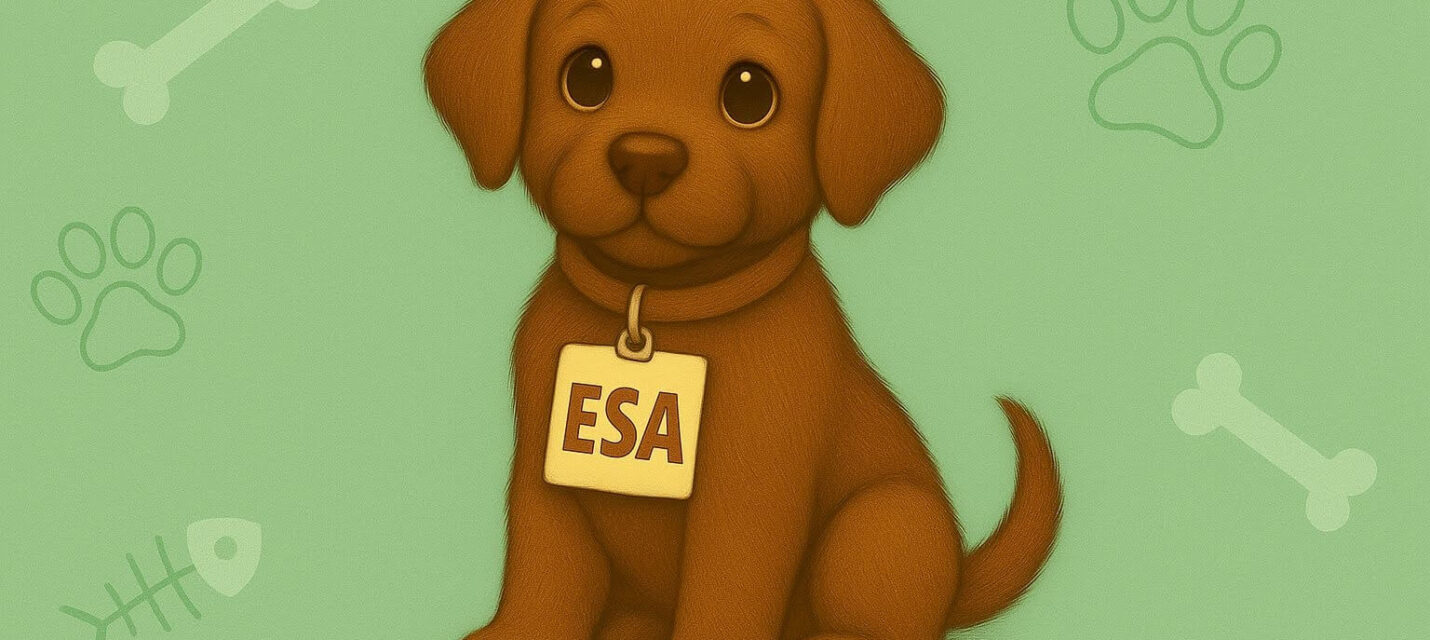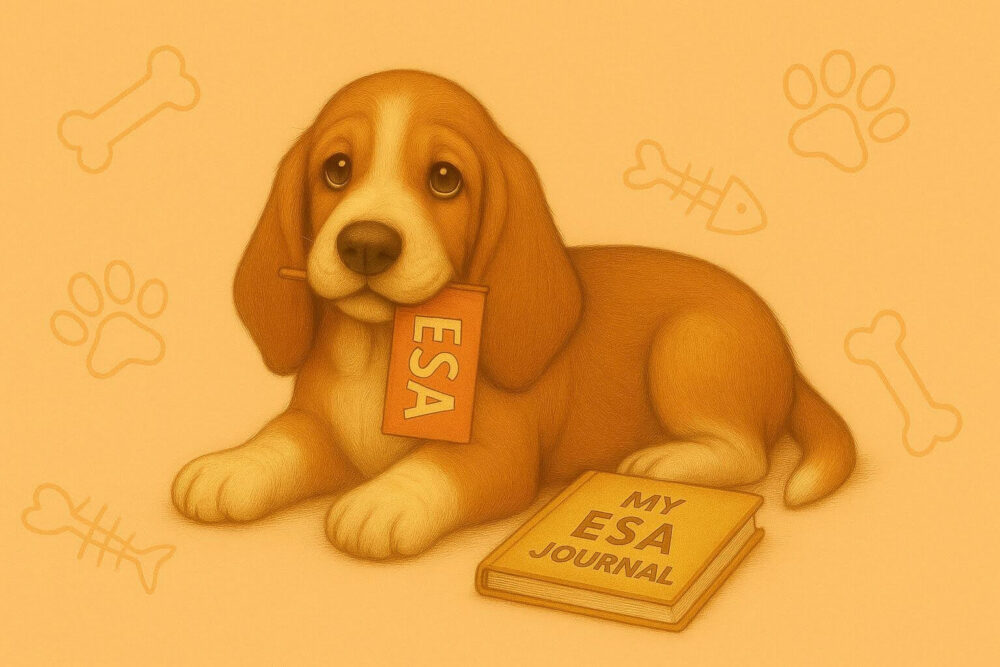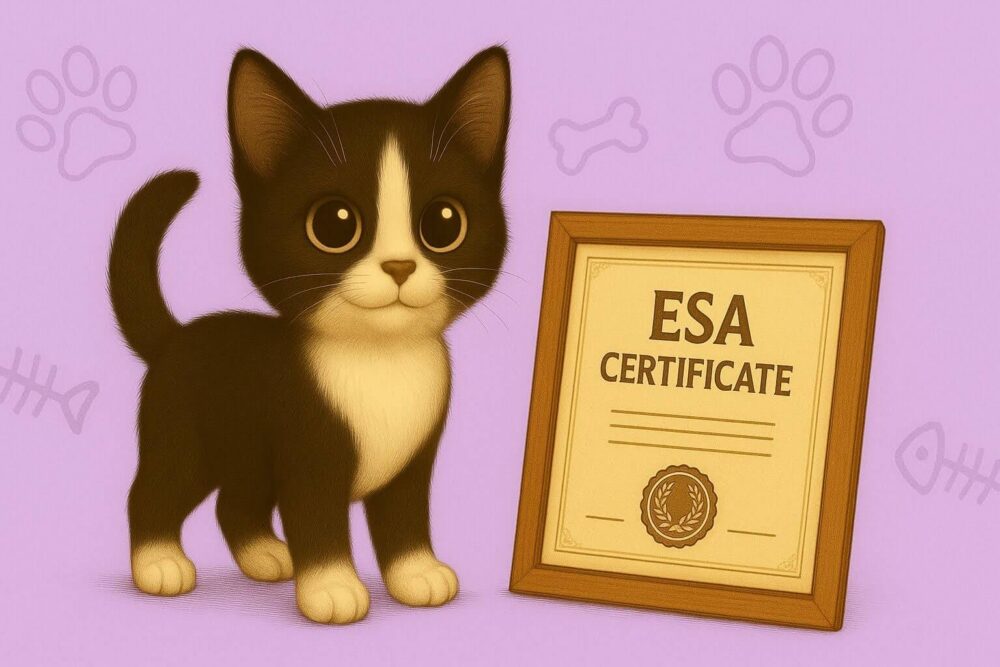
Table of Contents
When mental or emotional health challenges become a daily struggle, a weekly visit to the therapist may not be enough to recover. In such cases, an emotional support animal (ESA) can become your live-in cheerleader that provides unlimited free cuddles and always stays at your beck and call.
However, you can’t just randomly point your finger at any animal and say that it’s your furry support partner. There are certain emotional support animal requirements that need to be met to ensure your BFF is legally recognized and make your rental process hassle-free.
From what conditions make someone eligible for an ESA to the specifics of obtaining the necessary documentation, we’ll cover everything you need to know about ESA requirements.

What Are the Legal Requirements for an Emotional Support Animal?
The primary legal condition people need to fulfill to get an ESA is having a qualifying mental health condition directly mentioned in the Diagnostic and Statistical Manual of Mental Disorders (DSM-5-TR). These can be, but aren’t limited to:
- Chronic anxiety
- Depression
- Post-traumatic stress disorder (PTSD)
- Schizophrenia
- Personality disorders
- Psychotic disorders
Keep in mind that you can only be diagnosed by a licensed mental health practitioner (LMHP) in your state. If your local LMHP evaluates you and determines that you’re suffering from a condition that negatively impacts your daily life, activities, and emotions, they can prescribe you an ESA.
Typically, talking to your therapist is the easiest route, but in case you don’t have one, you can always reach out to other LMHPs, such as:
- Pediatric neurologists
- Psychiatric mental health nurses (PMHNs)
- Licensed clinical social workers (LCSWs)
- Psychiatrists
- Counselors
- Psychologists
- Nurse practitioners
But an LMHP will only prescribe an ESA if they determine that having a snuggle buddy tagging along will alleviate your symptoms and help you tackle any mental health challenges at home.
Note: Using information from random websites or social media to determine if you need an ESA is a recipe for disaster. Never try to self-diagnose, as it can lead to misunderstandings when you meet an actual medical professional.
How May an Animal Qualify To Be Recognized as an Emotional Support Animal?
By default, all animals (regardless of their breed) are qualified to be your partner in weathering any emotional storms. What really makes one “eligible” to be your ESA is their role in managing your mental health challenge.
For the most part, to be considered an ESA, an animal should:
- Live with a clinically tested patient in their home at all times
- Provide adequate comfort and emotional stability
- Directly help mitigate symptoms of mental illness
- Not cause undue hardship to the landlord or nearby tenants/neighbors
It’s good to know that, unlike service animals, ESAs don’t need specialized training. People can easily confuse the two since they’re typically brought up when you need a supportive furry friend.
However, ESAs aren’t meant to help you perform daily tasks, but rather offer companionship and help you remain stable. All those happy purrs and cozy snuggles won’t count as “assisting” with day-to-day activities.
Skim through the table below to learn what differentiates ESAs from service animals:
| ESA | Service Animal |
| Prescribed to people with clinically diagnosed mental health conditions, providing them with the necessary comfort and love | Provided to physically or mentally disabled individuals who cannot perform daily tasks without the help of an animal |
| Can’t accompany their owner in public spaces that don’t allow animals | Allowed to accompany their owner in public spaces |
| Protected by the Fair Housing Act (FHA) to prevent discrimination against renters | Governed by the Air Carrier Access Act (ACAA) and the Americans with Disabilities Act (ADA) |
| Don’t require any training | Given special training to help their owners perform daily tasks with ease |
What Disqualifies a Dog From Being an Emotional Support Animal?
Whether it’s a specific dog breed or any other animal, there are no laws that restrict any type of ESA. However, here’s when common sense applies; LMHPs aren’t going to prescribe an exotic animal, such as a ball python, to a patient going through depression.
Similarly, wild animals like lions and tigers are also out of the picture. The most common animals prescribed as ESAs are domesticated animals, such as cats, dogs, rabbits, etc.
Is an Emotional Support Dog Considered a Pet?
Under the FHA, ESAs aren’t labeled as pets. Instead, they’re treated as assistance animals who may not be trained to counter a disability but support people suffering from mental health challenges.
Unlike regular pets, ESAs enjoy specific housing rights. No landlord can turn them away (even in no-pet buildings) or wrongfully charge any:
- Pet fees
- Pet deposits
- Pet rent
Legally speaking, what separates an ESA from a regular pet is an ESA letter. This document informs property managers that your little furball is an ESA and specifies how it helps you alleviate your specific mental health issue.
Remember that only LMHPs can write an ESA letter and give your BFF official recognition once obtained. You don’t necessarily need to adopt a new animal from a nearby shelter either; if your LMHP decides that your current pet is a viable option, you can make them your ESA.

What Is the Minimum Age Requirement for Emotional Support Animal Adoption?
When it comes to the owner of an emotional support animal, there’s no age limit or a minimum threshold to pass. In fact, an LMHP, such as a pediatric neurologist, can prescribe an ESA to a child if they determine including a support animal in the treatment would be beneficial.
It may not be their first or even second option in mind, but if a pediatrician recognizes that a child connects well with an animal and finds them to help them stabilize emotions, it may be worth giving it a shot.
However, remember that only pediatricians who know your child’s medical history and are actively involved in treating them can prescribe an ESA. A pediatrician your child meets for the first time will probably not provide an ESA letter until they build a good relationship, so it’s best to consult an LMHP who’s already familiar with your child’s medical history and emotional struggles.
How To Obtain an ESA Letter
Now that you know the requirements both owners and animals should meet to be eligible for an ESA status, here are the three main steps to get your hands on a valid ESA letter:
- Visit an LMHP
- Get diagnosed
- Receive your letter
Visit an LMHP
The first step is contacting and scheduling an appointment with a nearby LMHP. If possible, reach out to someone who’s well-versed in your medical history and already familiar with your condition.
Get Diagnosed
At your appointment, an LMHP will evaluate your condition and determine whether you really need a support animal or if this may not be the most viable solution. Again, keep in mind that any emotional or mental health condition not directly mentioned in the DSM-5-TR won’t make you eligible to get an ESA. These can include issues such as:
- Work burnout
- Existential crisis
An LMHP will only introduce a support animal to your treatment if they’re certain a tail-wagging therapist is vital to your well-being.
Retrieve Your Letter
If your LMHP approves an ESA as part of your treatment, they’ll issue an ESA letter. You can then present this document to your landlord and request appropriate housing accommodations for your animal friend.
In case your landlord rejects this letter without a fair reason, you can file a HUD complaint for discrimination.

Wagging Into the Virtual ESA Letter Route
Instead of struggling to find a reliable LMPH, waiting in potentially long queues, and dreading uncomfortable office visits, you can easily get a prescription for your ESA online. The core process will remain the same, but the virtual route gives you more convenience since you can complete all the steps from home.
Here’s a super-quick rundown of what the process entails:
- Complete a pre-qualification quiz: Most online ESA platforms will include a quick pre-qualifying step. This helps them identify people who are likely to need an ESA compared to those who don’t
- Virtual diagnosis: Next, you’ll attend an online consultation with an LMHP who practices in your state and is eligible to examine your condition
- Get your letter: Upon approval, you’ll get your ESA letter within 48 hours, if not earlier. If you face any delays, contact the platform’s support team
While getting an ESA letter online is much easier, it requires a bit of caution. With more people now opting to support animals, many fraudulent websites have popped up to try to take advantage of potential ESA owners.
The Most Common Un-furtunate ESA Scams
Here’s a list of the most common ESA scams online to help you stay secure and ensure your ESA provider is a genuine one:
- ESA registration: To date, there’s no official government-backed registry that contains information on ESAs. And yet, some platforms market registering your ESA as an essential step when it’s not legally required. As long as you have an ESA letter, you won’t need another document
- DIY ESA letters: You may find editable online ESA letter templates, but taking this shortcut and skipping a professional evaluation isn’t the way to go. An ESA letter is a prescription, and trying to create one yourself without an LMHP can be considered forgery
- Suspiciously cheap or free letters: Talking to an LMHP doesn’t come without costs; you pay for their time and mental health expertise. That’s why any platform offering a free or extremely cheap ESA letter is likely a fraud. Scammers usually request an upfront fee to “unlock your letter” and disappear as soon as you enter your card details
- ESA certification: Similar to registration, you don’t need any certificates that show your faithful companion is an ESA
Paws for a Moment and Meet Your Service Animal—The Only ESA Provider You’ll Ever Need
When it comes to getting an ESA letter online, you can’t go wrong with Your Service Animal. With convenience, legal compliance, and speed as top priorities, you can easily get a genuine ESA letter with your loyal pal cuddled up in your lap.
Here’s a complete breakdown of all services:
| Feature | Description |
| Zero-cost online qualification quiz | All users complete a short quiz that helps the experts assess their need for an ESA before the full evaluation, eliminating any guesswork from the start |
| Fully online process | Every step of the process, from the quiz to letter delivery, happens online, so you can stay in with your BFF while getting all the paperwork done |
| Meet with licensed professionals | The platform will connect you with an LMHP who practices in your state and knows all the ESA requirements at play |
| Fast turnaround service | If approved, you’ll have access to your ESA letter in 24–48 hours |
| 100% money-back guarantee | You’re guaranteed a full refund if the LMHP doesn’t approve you or your ESA letter is denied by your landlord |
Getting an ESA Letter With Your Service Animal
Your Service Animal makes the process of getting an ESA letter simple. Just follow these four steps:
- Find out if you’re a good fit for an ESA letter with our online quiz
- Schedule an online appointment with a licensed mental health practitioner in your state
- Attend the online call and receive your ESA letter if clinically appropriate
- Receive a full refund if the therapist doesn’t issue an ESA letter or your landlord rejects your letter








